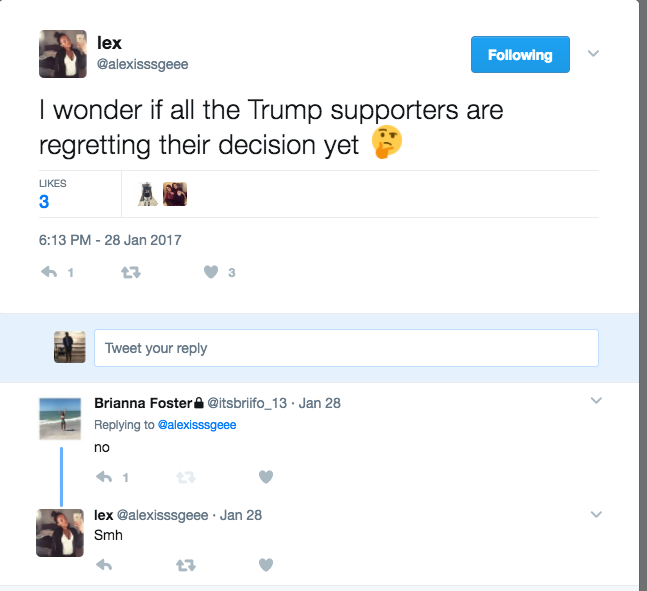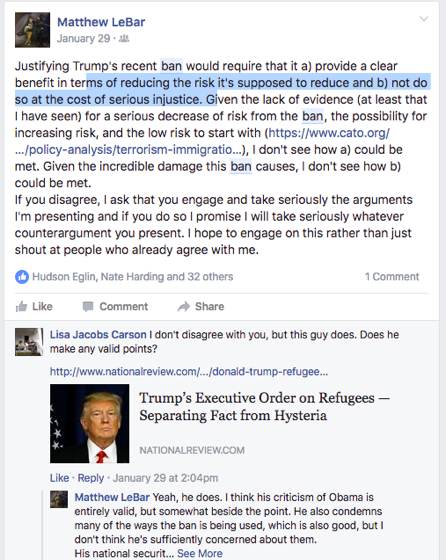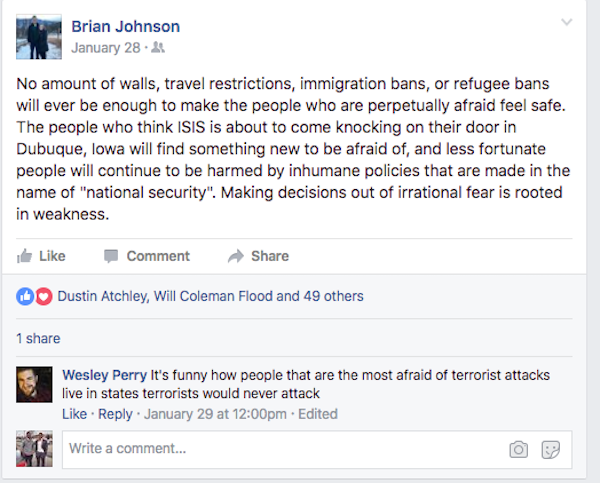Twitter’s Punchline Response vs Facebook’s Full Critiques of the Trump Administration Travel Ban
Recently, social media exploded over the travel ban put into place by the Trump administration. Facebook and Twitter were both flooded with posts, but the different media platforms enabled different kinds of responses. Facebook allows for more interactive discussions than twitter’s 140-character limit tweets, which enables for quick punchlines that don’t have to incite a response
I will examine critical posts from both my Facebook and Twitter timelines. Both sets of posts include the demographic of an age range that varies from college aged students to adults.
Twitter reactions were often quite explosive when showing their discontent for the travel ban. The 140-character limit posts simply criticizes the policies laid out by the administration instead of harboring room for conversation. Each post takes a reactive stance toward the policy rather than fleshing out full drawn out ideas to support their reaction. Each tweet is tied to a personal reflection drawn from the authors feelings.



As seen in the chains of tweets the posts may garner popularity through likes and retweets, but do they allow for others to step in and challenge or defend the claims of the argument? While examining these tweets, you see that they often fail to give you the complete context of their sentiments. The tweets simply react with feelings and emotions of perplexity, confusion, discontent, and hopelessness.
 The authors of these tweets are encourage to express their raw opinion through tweets. These sentiments lead to tweets like Ty’s where, she expresses her discontent with not only the policy, but attacks the presidents character as a whole.
The authors of these tweets are encourage to express their raw opinion through tweets. These sentiments lead to tweets like Ty’s where, she expresses her discontent with not only the policy, but attacks the presidents character as a whole.
Facebook posts regarding the restrictive travel ban on the other hand yielded longer responses that included more testimonials, evidence, and related to their critiques of the law. The posts offer more than just a simple reactionary statement to their own opinion, but add in the thought process of why they feel so strongly against the ban. The Facebook posts elaborate into more complete critiques.


In most posts you see an argument that is not only responsive, but an argument that is more inductive. Facebook promotes thought out discussions and comments that are longer in length that are in conversation about the evidence that formulates from each critique. Each post attacks different nuances like what are the true benefits of the policy, how does the policy align with the “American Dream”, and why we must be compassionate and not unjust. These posts allow for a deeper connection with the other users drawing them to be more compelled shown by the greater number of comments, likes, and shares.

 Brian’s posts actually help quantify Facebook’s ability to promote more wholistic arguments that invite responses because he authored a post on both platforms. Brian’s Facebook post comparatively to his work on Twitter was much more appreciated. Brian’s Facebook post in a way serves as an extension of his reaction on Twitter. Brian fleshes out a more detailed argument in his Facebook posts, and it expands upon his perplexed thinking emoji and theologian reference that he uses in his Twitter post. The argument comes to full fruition on Facebook as he justifies his critique. He critiques with the notion that the ban simply operates out of fear. He also explores the ideas that the policy is in humane and that slapping the title of national security across the agenda does not make it better. Facebook allows him to become more argumentative, and therefore he can resonate with more people.
Brian’s posts actually help quantify Facebook’s ability to promote more wholistic arguments that invite responses because he authored a post on both platforms. Brian’s Facebook post comparatively to his work on Twitter was much more appreciated. Brian’s Facebook post in a way serves as an extension of his reaction on Twitter. Brian fleshes out a more detailed argument in his Facebook posts, and it expands upon his perplexed thinking emoji and theologian reference that he uses in his Twitter post. The argument comes to full fruition on Facebook as he justifies his critique. He critiques with the notion that the ban simply operates out of fear. He also explores the ideas that the policy is in humane and that slapping the title of national security across the agenda does not make it better. Facebook allows him to become more argumentative, and therefore he can resonate with more people.
I post not to say Twitter is inferior to Facebook or comment on whether one is better than the other. Facebook and Twitter are different forms of social media each having their own way of influencing its users. In regards to the travel ban Twitter allowed us to react with 140-character response reactions to the policy and make brief critiques without needing a full fledged argument. Facebook allows users to create full posts that discuss the entirety of our emotional attachment and our evidence toward our critiques of the Trump Administrations travel ban. The differences affect not only how we use each platform, but how we respond on each platform. Facebook allows for more full discussion and discourse about the evidence where Twitter allows for witty punchlines and retorts.

Alex,
I really enjoyed your use of examples! They helped strengthen your argument and make the post easy to follow.
One thing I think you can work on is making your argument a little more detailed. Your thesis takes a few sentences to get to and could be summed up a little better. For example, you say “each media platform allows for different kinds of interactions.” I think you could go ahead and specify what these kinds are to get to your point a little quicker and simpler. In terms of visuals, I think the pictures could be ordered a little more to give the reader some navigation and to make the post look cleaner.
Something to think about is what is twitter’s purpose? Clearly twitter may not be the best medium for discussing politics, so what might be better suited to a tweet?
Alex
This was one topic I was thinking about covering and I think you did a great job doing so. I too see the difference between facebook and twitter and the reactions on an emotional v analytical level. You mention that people can’t challenge others voice on Twitter, as in they cannot comment on others posts. I don’t use twitter that often but can’t you comment on a retweet. That being said, I think it would be fun to talk about how in depth, responses are on Facebook, and the long response chains that some facebook posts get. Does their ability to have more of an argument, create more conversation?
Pingback: girl with girl sex games